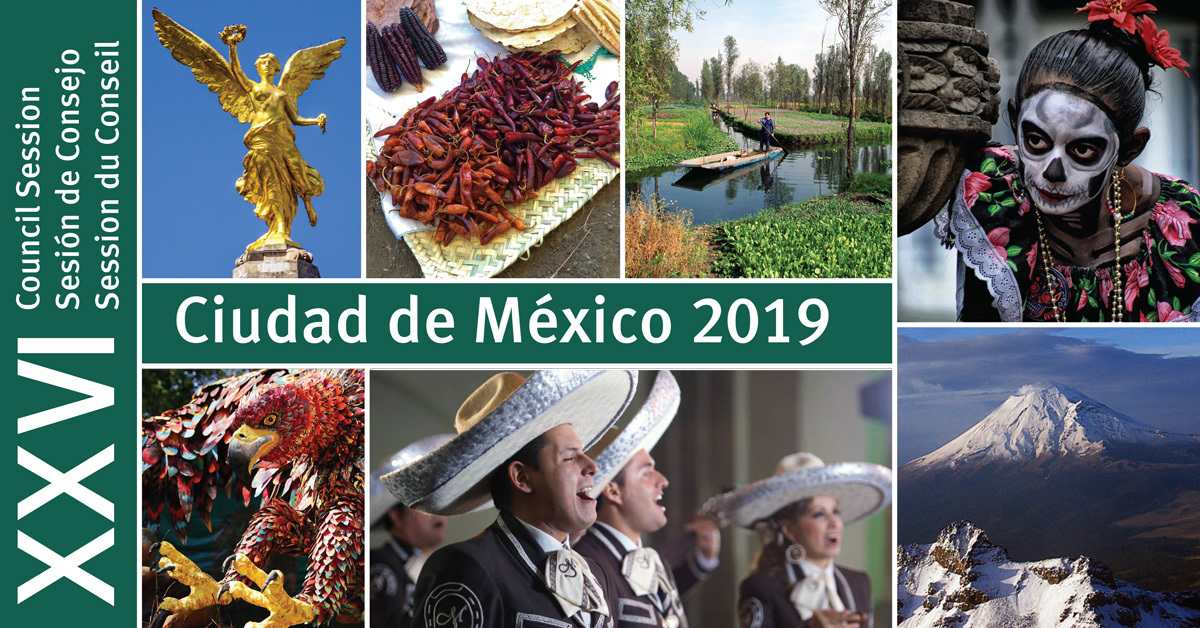CEC Council Statement – 2019
Twenty-Sixth Regular Session of the CEC Council
Montreal, 25 June 2019—For the past twenty-five years, the Governments of Canada, Mexico and the United States, in collaboration with civil society across North America, have worked together through the Commission for Environmental Cooperation (CEC) to advance our shared environmental priorities. Created in 1994 by the North American Agreement on Environmental Cooperation (NAAEC), the CEC has been an innovative and successful forum for trilateral cooperation, involving governments, local and Indigenous communities, academia, the private sector, and youth, to conserve, protect, and enhance the North American environment in the context of expanded trade.
From Oklahoma to Mexico City
On this 25th anniversary, we are implementing the initiatives on extreme weather and climate events and innovation hubs that we announced at our 2018 Council Session in Oklahoma City. These projects aim to improve our preparedness, response, and resilience to extreme weather and climate events through enhanced capacity for monitoring droughts, wildfires and smoke; remote sensing of fires; and assessing the costs of floods. We also launched the North American EcoInnovation Network to provide the necessary knowledge, resources, and tools to cultivate youth and community leadership in innovation, entrepreneurship, and sustainable development.
Today, our public forum provided us a rich dialogue with experts from government, nongovernmental organizations, and the private sector, as well as members of the public, on “Circular Economy and Resource Efficiency.” We explored synergies and opportunities between our domestic and regional efforts with activities in civil society and the private sector to achieve positive results in addressing marine litter and food loss and waste and their environmental, ecosystem, climate and economic impacts.
CEC Operational Plan 2019–2020
We are pleased to successfully complete our 2017–2018 Operational Plan and announce our new plan for the next biennium. Over the last two years we have developed trilateral approaches to reduce marine litter in shared watersheds, piloting these efforts in the US-Canada border Salish Sea and US-Mexico border Tijuana River watersheds. We also provided tools to manufacturing supply chains in the chemicals and automotive sectors to manage energy use and reduce costs and all emissions, including greenhouse gases, to improve competitiveness and public health. We developed voluntary guidelines and tools for our food supply chain and consumers to measure and minimize food waste to maximize potential economic, sustainability, and climate benefits. Building on these successes, our new Operational Plan continues to strengthen our capacities in these key areas, as well as in those of hazardous waste management and transfers, marine protected areas, pollinators and ecosystems, weather and climate resiliency, and traditional ecological knowledge. Our regional work on marine litter and extreme events produces valuable information that is also supportive of efforts in other fora, such as the G20.
Youth Innovation, Entrepreneurship and Partnerships for Green Growth
We completed the third edition of the Youth Innovation Challenge, promoting youth entrepreneurship and innovation for sustainable development. We are proud to support the winning projects, focused on transforming waste into sustainable materials to replace masonry blocks and furniture pieces, turning organic waste into quality animal feed, and using robots to deliver ultraviolet light as an alternative to pesticides in strawberry farms.
Stakeholder engagement and community action
We acknowledge the valuable contributions made by the Joint Public Advisory Committee (JPAC) and its continued engagement with civil society to inform our work on building communities that are more resilient to extreme weather and climate events. We are also continuing to empower civil society and local and Indigenous communities to act on sustainability issues, by devoting resources to another round of the North American Partnership for Environmental Community Action (NAPECA) for local community action projects.
Our stakeholders continue to engage through the Submissions on Enforcement Matters (SEM) mechanism, with five submissions filed over the last year to promote the effective enforcement of environmental laws and regulations in our three countries.
Looking forward
As we conclude the 25th anniversary meeting of the Council, we are proud that the CEC was the first trilateral forum for promoting a regional collaborative approach to environmental protection in North America. As we look to the future and to the modernization of our continued cooperation, we share a vision for this forum to continue advancing trade and environment priorities, including environmental and ecosystem protection, and innovation and partnerships for sustainable growth. In closing, we thank César Rafael Chávez for his valuable contribution and commitment in leading the CEC Secretariat these last three years.
We look forward to meeting next year in Canada.

About the CEC
The Commission for Environmental Cooperation (CEC) was established in 1994 by the governments of Canada, Mexico and the United States through the North American Agreement on Environmental Cooperation, a parallel environmental agreement to NAFTA. As of 2020, the CEC is recognized and maintained by the Environmental Cooperation Agreement, in parallel with the new Free Trade Agreement of North America. The CEC brings together a wide range of stakeholders, including the general public, Indigenous people, youth, nongovernmental organizations, academia, and the business sector, to seek solutions to protect North America’s shared environment while supporting sustainable development for the benefit of present and future generations
The CEC is governed and funded equally by the Government of Canada through Environment and Climate Change Canada, the Government of the United States of Mexico through the Secretaría de Medio Ambiente y Recursos Naturales, and the Government of the United States of America through the Environmental Protection Agency.